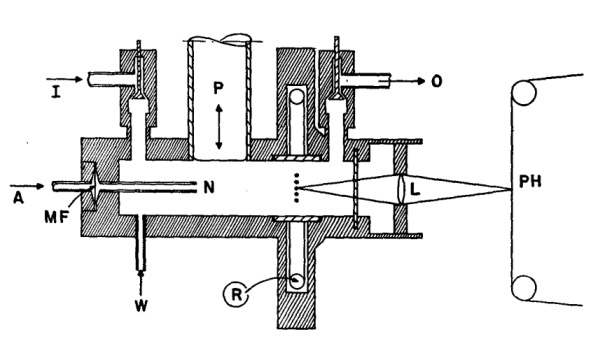Purpose of the flight and payload description
The objective of the flight was to measure the vertical profile of the concentration of Aitken particles (particles with radii smaller than 0.14 microns) using an Aitken Nuclei Counter developed by the Air Force Research Division of the Air Research and Development Command.
This instrument was based on the principle that if a highly illuminated cloud of water droplets is photographed, the picture consists of dots and circles depending upon the location of the droplets with respect to the focal plane. For a given photographic objective, the diameter of the circle determines the distance of the droplet from the focal plane. All droplets smaller than a certain size are located between two planes parallel to the focal plane. For a given optical system, an absolute determination of droplet concentration is thus possible, provided that the illumination is strong enough to depict all droplets within the two limiting planes.
The schematic diagram at left show the essential parts of the counter (click to see details). It consisted of a cylindrical chamber, 12.6 cm long and 2.8 cm in diameter, expanded by the action of a piston (P) at a ratio of 1,23. Operation of the nuclei counter was continuous and autonomous during the balloon flight, according to the following cycle: before and after expansion, the valves (I and O) were opened, and the chamber was flushed with outside air at the rate of 50 cm3 per sec for 20 sec. Air entered the chamber through a half-inch intake tube, about 12 inches in length. Valves I and O were then closed and clean air (A) from a tank was injected for 4 sec, raising the pressure of the chamber to one-half atmosphere above ambient. The air was allowed to rest in the chamber for 5 sec for mixing and moistening and then the piston was withdrawn, causing expansion. About 0.3 sec after expansion and consequent formation of the fog, a high-intensity strobe light (R) illuminated a cylindrical section of the chamber about 1.5 cm long, which was photographed by a 35-mm Beattie-Coleman camera (PH) together with the time and the frame number. Finally, water (W) was injected from a reservoir tank into the chamber, and the cycle was repeated. The counter was designed to take measurements on the ascent only.
Details of the balloon flight
Balloon launched on: 5/27/1960
Launch site: Joe Foss field, Sioux Falls, South Dakota, US
Balloon launched by: Raven Industries Inc.
Balloon manufacturer/size/composition: Zero Pressure Balloon
End of flight (L for landing time, W for last contact, otherwise termination time): ??/??/1960
External references
- Stratospheric aerosols Journal of the Atmospheric Sciences, Volume 18: Issue 1, 1961
- Vertical profiles of condensation nuclei in the stratosphere Journal of the Atmospheric Sciences, Volume 18: Issue 4, 1961
15937If you consider this website interesting or useful, you can help me to keep it up and running with a small donation to cover the operational costs. Just the equivalent of the price of a cup of coffee helps a lot.


